Honey Bee Farming Guide:
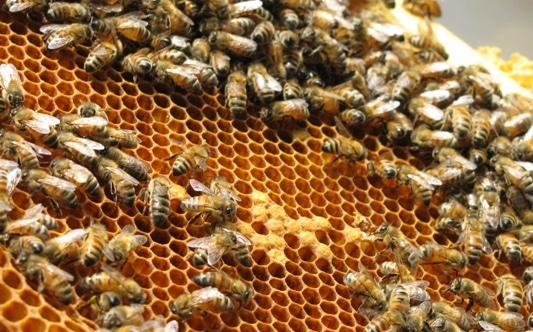
Introduction of Honey Bee Farming:- Well, Beekeeping is one of the oldest tradition in India for collecting the honey. Honey be farming is becoming popular due its market demand in national and international markets as well. Not only the farmers make a sweet dividends but beekeeping also help increase agriculture productivity through pollination. Honeybees also produce honey, bee wax and royal jelly thus giving additional benefits to the farmers. After successive losses in traditionally grown crops, farmers are inclining towards bee farming. In order to maximize agricultural production, honeybee can be used as an important input agent. About 80 % crop plants are cross-pollinated, as they need to receive pollen from other plants of the same species with the help of external agents. One of the most important external agents is the honeybee. Farmers planning for commercial honey bee farming should consider taking apiculture training. Usually, a colony consists of a queen, several thousand workers and a few hundred drones. There is a division of labour and specialization in the performance of various functions. They build nests which are called as “combs” with wax, which is secreted from the wax glands of worker bees. The bees use their cells to rear thin brood and store food. Honey is stored in the comb upper part. Under the comb, there should be rows of pollen storage cells, worker brood cells and drone brood cells. Some bee species build single comb in open where as others build multiple combs on dark cavities. Farmers can utilize honeybees for their pollination services or to obtain products from them. The methods used depend on the type of bees available, and the skills and resources available to the beekeeper.
Castes of Honey Bee:- Basically, every honey bee colony comprises of a single queen, a few hundred drones and several thousand worker castes of honey bees. Queen is a fertile and functional female where as a worker is a sterile female and the drone is a male bee insect.
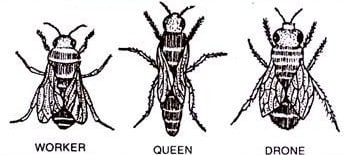
Different Species of Honey Bee:- There are 5 important species of honey bees and they are listed below.
- The Indian hive bee.
- The rock bee.
- The little bee.
- The European or Italian bee.
- Dammer bee or Stingless bee.
Steps to Know Before Starting a Honey Bee Farming Project:– Generally there are certain steps to keep in mind before going for beekeeping.
- The first step in planning a beekeeping project is to become familiar with the bee-human relationship in your area where you want to set up. Know more about bees by involving practically.
- It is advised to work with local beekeepers especially If you have no experience working with bees. Learn and follow their advices in beekeeping management. It is quite common having bee stings and they are part of beekeeping.
- Once you have become familiar with the local bee-human relationship, ideas for introducing improved methods should be formulated and then make a perfect plan for equipment to use and Where to market hive products.
- If you are just beginning with bees, plan to work with just 1 or 2 individuals in the area.
- It is recommended to start beekeeping with at least 2 hives. This gives an opportunity to compare the progress between a number of hives which allows the project to continue should one colony die out. Also, management aimed towards an apiary instead of individual hives can be stressed out.
- While planning a project, set realistic goals and go for a small project first then after getting experience in beekeeping it is better off to for a large one.
- The equipment to be used in a project depends on the local situation. You should assess the availability of needed inputs as well as the technical aid available in choosing what type or types of hive equipment are appropriate for your area and type of bees.
- Beekeeping equipment plays major role in succeeding the project. Identifying people in an area who can make beekeeping equipment and getting it made can be success in itself. It can require a lot of patience to coordinate getting the equipment together.
- To market hive products, identify any local agent or deal with already established market. Find out with other beekeepers for marketing ideas. Farmers can also get in touch with local department of agriculture. Usually, local bakers and candy makers are a potential market for honey.
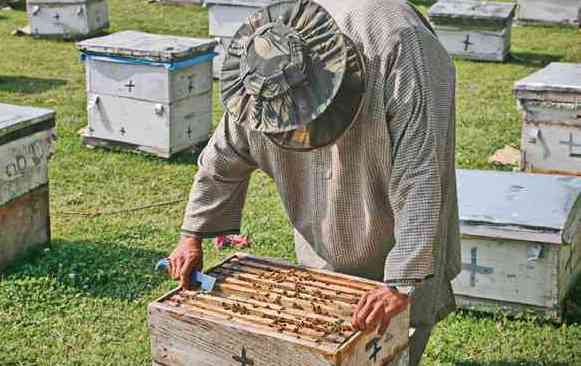
The prerequisites to start a Honey Bee Farming (Beekeeping) are as follows:
- Knowledge and training on beekeeping. For training on beekeeping, contact your local agriculture department or agriculture university.
- Knowledge on local bee flora.
- Sufficient local bee flora.
- Knowledge of migratory beekeeping.
Site Requirements in Honey Bee Farming:-
- The selected site should be dry without dampness. High RH will affect bee flight and ripening of nectar.
- Clean natural or artificial source of water should be provided.
- Trees serve as wind belts in cool areas.
- Hives can be kept under shade of trees or artificial structures should be constructed to provide shade.
- Plants that yield pollen and nectar to bees are called bee pasturage and florage. Such plants should be plenty around the apiary site.
Honey Bee Farming Equipment:- Here are the equipment used in most of the commercial honey bee farming. However, find out with local beekeepers for appropriate agriculture equipment needed.
Thin & thick beekeeping brushes, SS knives, SS & iron hive tools of L shaped & curved shaped, Food graded plastic made queen cage, queen gate, hive gate, Honey Extractor, Smoker, Queen Excluder, Pollen Trap, Propolis Strip, Royal Jelly production & extraction Kit, Queen rearing kit, Bee venom Collector.
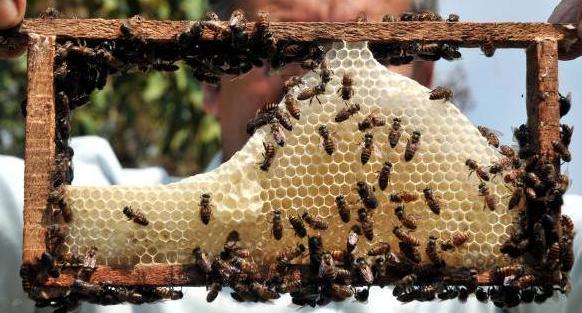
Crops benefited by Bee pollination in Honey Bee Farming:-
- Fruits and nuts: Almond, apple, apricot, peach, strawberry, citrus and litchi
- Vegetable crops: Cabbage, coriander, cucumber, cauliflower, carrot, melon, onion, pumpkin, radish and turnip.
- Oilseed crops: Sunflower, mustard, safflower, niger, rape seed, gingelly.
- Forage seed crops: Lucerne, clover.
Yield Increase Due to Bee Pollination in Honey Bee Farming:-
| Crop | % yield increase |
| Mustard Sunflower Cotton Lucerne Onion Apple |
44 32-45 17-20 110 90 45 |
Management of bees for pollination in Honey Bee Farming:-
- It is recommended to place hives very near the field to save bee’s energy.
- It is recommended to migrate colonies near the field at 10 % flowering.
- It is recommended to place colonies at 3 per ha for Italian bee and 5 per ha for Indian bees.
- The colonies should have at least 5 to 6 frame strength of bees and with sealed brood and young mated queen.
- Should allow sufficient space for pollen and honey storage.
Pests and Diseases in Honey Bee Farming:-
- Wax moths, Ants, Wasps, Wax beetles, Birds, Tracheal Mites, The parasitic mite Varroa destructor, Bee mites, Brood mite are the common pests found in honey bee farming.
- Nosema Disease, European foul-brood disease, American Foul Brood, Sac-brood disease (SBV),Thai sac brood virus (TSBV), Chalk brood disease and stone brood disease are the main diseases found in the honey bee farming. For control measures of these pests and diseases, contact local department of agriculture.
Harvesting of Bee Products in Honey Bee Farming:- Honey, Bes Wax, Royal Jelly, Bee Venom, Propolis & Pollen are the main bee products. Honey should be harvested at the end of a flowering season. In traditional or top-bar hives, the beekeeper should select a comb which contain ripe honey covered with a fine layer of white beeswax, usually those nearest the outside of the nest. Honey is extracted only from super combs using honey extractor equipment.
Economics of Beekeeping:- The following is the cost and profit details of beekeeping Project. Initial Investment may be as low as 2, 25,000 Indian Rupees. The best season to start beekeeping is in August to September.
Here is the sample Beekeeping project report.
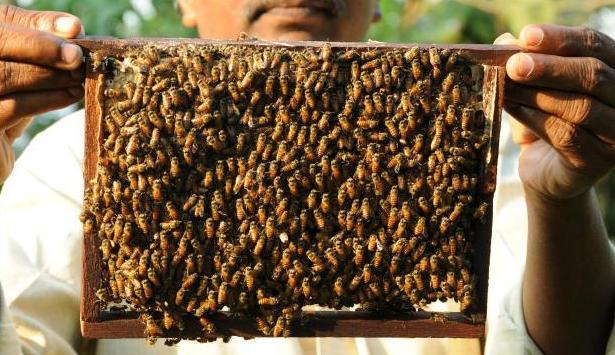
Assumed Units: 80 no’s of bee colonies.
| Non-Recurring Expenditure | ||
| S.no. | Item Details | Amount in Rupees |
| 1 | Cost of 10 no. of beehives per box | 2000*80 =1,60,000 |
| 2 | Cost of 80 bee boxes | 80 * 400 = 32,000 |
| 3 | Cost of apiery equipment | 5,000 |
| 4 | Cost of honey units + uncapping tray | 12,500 |
| 5 | Bee wax sheet 1 kg | 350 |
| Returns of Honey Production | ||
| S.no. | Item Details | Amount in Rupees |
| 1 | Honey production 80 Rupees * 40 kg | 3,200 Rs/Box |
| 2 | For 80 Boxes = 80 * 3,200 | 2.56.000 |
| 3 | Skilled Labors cost 5000 * 12 | 60,000 |
| 4 | Unskilled labors cost 3500 * 12 | 42,000 |
| 5 | Migration charge | 20,000 |
| 6 | Feed charge annual | 10,000 |
| 7 | Total | 1,32,000 |
| 8 | New 25 box * 700/-each | 17,500 |
| 9 | Net profit | 1,49,500 |
Return expenses = Honey production – net profit = 272000 – 149500 = 1, 22,500 Rs
Bee’s increase (25*1800) = 45,000 Rs
Net profit annual = 1, 67,500 Rs which is an excellent Profit.
Note: In subsequent years, there won’t be any Non-Recurring Expenditure, hence profits will go up.
For Asia Farming : Read here.
For Sheep or Goat Farming: Read here.
hi, do you provide any training or seminar on apiculture.
can you provide information on where we can get the supplies.
Hi, We don’t have any training information about apiculture. However, you can read about beekeeping (apiculture) here: https://www.agrifarming.in/honey-bee-farming-information-guide/
Sir I want to start a poultry farm with the help of government subsidy and also require any details of honeybee farming scheme.
Contact Rural Agriculture Bank or NABARD at https://www.nabard.org
You can contact Any agriculture rural banks or NABARD
plants recommended for honey bee farming . planing in my farm house. flora 12 months plants. can plant 600 . recommend . rainy season start. for Nanded Maharastra
9325311001
do you sell beeswax?
kindly let me know where can I buy 100 % pure honey without mixing of any antibiotic.
Could you tell me where can I find the Bee Pollen for Bee farming. I want to buy in a large amount. Where can I buy in wholesale?
Thank you
Hi,
I am looking to start beekeeping in Tamil Nadu. Can anyone please help me in getting the correct contact number.
Thanks
Krish
How is Dehradun’s environment, for starting a bee farm? Is 4 bigha land enough to start a bee farm?
For climatic conditions of Honeybee Farming check this: Honey Bee Farming Project Report.
I want to know following information on bee farming on my second floor terrace of my independent house in a residential area in kodigehalli, very near GKVK campus, about 3 km from Hebbal flyover junction and 1.5 km from International airport road in Bangalore.
Is it safe to keep a beehive on top of my house with access to people for drying clothes, terrace gardening.
Is there a risk of biting by bees and bees coming into the house?
Risk to children
Precautions to be taken if I want to do honey bee farming at home
We have some trees, vegetable and flower plants in our compound
The neighborhood is reasonably well populated
Can the same hive infrastructure again and again or I have to replace after each harvest?
Can I harvest the honey myself without the need for any expert? How risky it is?
What is the value of the wax of which the mesh is made? Medicine, consumption, nutritional value?
How much should a trial box cost? Should I have all infrastructure to start with or only the bee-hive from which I will extract honey manually?
Is there any maintenance work involved after setting up?
Any other caveats or precautions or warnings in getting into this business?
I don’t plan to harvest and sell honey, but only for own home use.
It is not advisable according to your information.
I have two questions.
1) is there any scheme for Indian desi cow project. I wish to start with 10 cows
2) Do you have any schemes or subsidies for a poly house of 100000 sq ft.
Your local NABARD office is the right point of contact for Dairy and polyhouse farming subsidies and loans. However, here is some information.
Read: How to get NABARD Subsidy for Dairy Farming.
Sir,
Any Subsidy Giving For Bee Keeping (Honey Production)?
Where can I buy a new colony or a nuc box of bees for starting a bee farm?
Hello Sir/Madam,
I am Planning for Bees Forming , need your help, need more information
I want to go through a training in Beekeeping in Delhi/NCR. Can you please provide information about the training programmes and organisers here?
Any programmes for schools in Hyderabad? We would like to spread awareness about bees and possibly keep a beehive on the school campus. Who could help us?
Sir, I have to train on Bees Culture, Sir, I live in Ranchi (Jharkhand). Is there an Apiculture frame nearby sir
Sir, I want to start own honey bee farming. I am from nimapara, odisha, 752113 need training.
Need help.
i would like to do honey bee farming but i do not know where to them from
if you could supply me with necessary equipment with a price i would be happy to purchase
sir, I’m interested to start honey bee farming. I’m from Chittoor, Andhra Pradesh. please suggest following
1. How can get training on forming?
2. There is any subsidy availbel for this?
3. Please suggest the initial project cost
Sir, whom should I contact to start bee farming?
I like the depth of knowledge shown.I am interested in bee farming. People in my village have a traditional way of doing this but i think it needs some modernising. I am a Ghanaian and i live in ghana. How can we discuss further about this?
Sir i need to information about bee farming at maharashtra or in up.Please give me info.
I really I impressed
Sir I need a information about bee forming at karanataka, please give me information